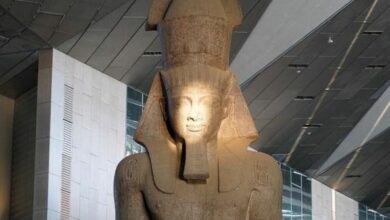On 29 November, 57.5 percent of Swiss voters came out in favor of a referendum banning the construction of minarets in Switzerland. The vote, though controversial, does not lack legitimacy: 53.4 percent of eligible voters participated in the referendum.
Husam Tammam is the editor of the cultural page at www.islamonline.net and is also a researcher with Religioscope, a Swiss research center that focuses on religious issues in that country. Tammam sat with Al-Masry Al-Youm to discuss the referendum in a larger context and to elucidate some of the issues at stake after it has passed.
Al-Masry Al-Youm: I heard you say at a conference two months ago that there was a lack of uproar in the Muslim world at the time even though the proposition to ban the construction of minarets had already received enough signatures to be voted on as a popular referendum. You said at the time that Islamonline’s coverage, which stressed that the proposition emerged from the Swiss Right, had helped to diffuse tension over the referendum. But now it seems that the situation has changed. Why?
Hussam Tammam: What I said in the beginning was connected to the prevailing idea in Arab and Muslim opinion that those pushing for the minaret ban represented the margins of Swiss society. The situation changed when the proposition was put to a vote and approved by a 57.5 percent margin, meaning this was a popular position. Herein lies the problem. It is now impossible for the moderate Muslim voices that call for understanding and calm to say that this proposition is really coming from the margins of Swiss society.
There is also a problem within Arab public opinion in that it doesn’t understand the nature of direct democracy as it exists in Switzerland. Direct democracy allows actors outside the political arena to put forth popular initiatives for the change of laws and the constitution. I’m of the opinion that the Swiss government, as well as the major political parties and Swiss civil society organizations, did their duty and they are not responsible for what happened. Most of the votes came from people who were not able to announce their positions or opinions on the minaret ban either to the press or to the organizations carrying out public opinion polling. As soon as they were given the chance to vote secretly, they did. Also, the major political powers in Switzerland made a big mistake by not having an organized conversation that focused on a blanket rejection of the extreme right’s. They clearly underestimated the power of the Right. The Right exploited recent issues, such as the Palestinian soldier who killed a number of soldiers at an American base, the debacle with Qaddafi, his son and the Swiss administration, and the Taliban. So the right was able to mobilize around all sorts of popular issues while the Left didn’t have the ability to mobilize people around anything.
Al-Masry: How do these popular initiatives work?
Tammam: Direct democracy in Switzerland allows a marginal force in society to put forth initiatives to amend the law or even the constitution via popular referendum without passing through parliament. For example, if this initiative was put in front of the Swiss parliament, it would be rejected by the Second Chamber. All of the major Swiss political parties rejected it, but it is possible with direct democracy and Swiss Federalism to put forth any initiative that has received a minimum 100,000 signatures before popular referendum. If the popular majority and the majority of cantons agree with the initiative, it is adopted constitutionally. This is exactly what has happened.
Al-Masry: Could we say that the problem Switzerland faces today concerns the symbols and the ideology of Islamism and not the Muslim community?
Tammam: Totally. The minaret issue has no relation to social or political problems specific to Muslims. There are more than 300,000 Muslims in Switzerland. This is a big number and it has increased rapidly from 30,000 to 300,000 in a quarter of a century. The Muslims are assimilated socially and politically. There is not religious extremism in Switzerland. On the contrary, the condition of Muslims in Swiss society is considered to be a model compared to, for example, France and Germany. But the problem is that with the influence of globalization, symbolic causes have arisen that tend to take priority in the collective imagination over economic, political, and social issues. I’m of the opinion that the French model is responsible for the export of these battles to countries like Switzerland. I mean, the burqa and the hijab are now the most discussed topics in Switzerland related to Islam, even though they are not connected to rights and responsibilities, nor to political, social or economic issues. They are connected to religious symbols in a public space that is considered secular. So here is the problem. These issues are symbolic and not tangible. Therefore the Swiss Right wages a war against symbols. This is strange, because there wasn’t a battle in Switzerland beforehand with Islam. There was never such thing as Swiss colonialism, or wars between Switzerland and the Islamic world. On the contrary, Switzerland has constantly been an example of democracy and neutrality because the country itself created the policy of neutrality.
Al-Masry: Do you think this vote is racist?
Tammam: I am of the opinion that the vote is not terribly significant because it is not aimed at an essential aspect of the Muslim faith like the prayer, the hijab, or other fixed religious principles. Construction of minarets is not a religious obligation in Islam. But the danger is that this vote indicates a radicalization in the way the West as a whole perceives Islam, not just Switzerland. This reaction will directly affect the peaceful condition in which Muslims live in Switzerland, particularly considering that a large portion of them came from Turkey, an even bigger portion from the Balkans, and that all these groups that don’t have the same issues of identity as, say, the Arabs. So symbols will become the focal point in the war for identity. This will eclipse the political, social and assimilation issues and the political rights and it will lead to counter-extremism, damaging the idea of Swiss and European citizenship. Also, these issues create gripping headlines that mobilize those who are searching for influence. This means that the two parties that put forth the issue were looking for ways to strengthen their political positions. So they chose to mobilize around cultural issues because these are the issues that will easily catch on in the street.
Al-Masry: How many mosques are there in Switzerland now?
Tammam: There are approximately 250 mosques and places of prayer. Of these, only four have minarets and there is a fifth for which a minaret was approved a few months ago. So the minaret is not a real issue in Switzerland. The economic situation of the Muslim community doesn’t allow it the luxury of constantly building minarets because they cost a great deal of money to erect. So it is a side issue.
Al-Masry: Do you think that that what’s happening in Switzerland is not just a Swiss problem but a European problem?
Tammam: The problem is most evident in France where secularism goes beyond just being a framework for organizing political and legal affairs to such an extent that it becomes an ideology. There is a constant battle between secularism and any symbols or practices that might injure the sensibilities of the secular. Initiatives were put forth to ban the hijab in schools, and you might understand this in light of the fact that schools in a republican system have a political function. But what Sarkozy put forth related to the burqa, in spite of the fact that the burqa isn’t popular in the Islamic world, is that the rejection of the burqa is complete and does not only concern the public sphere. This debate about these symbols started in France but was made law in Switzerland, because the local form of direct democracy allows for populist initiatives. And so Switzerland came along as a platform to test this idea, and afterwards parties on the Right in Holland and Germany came along and said why don’t we put forth our own initiatives on the minarets, and then the Right that won in Switzerland began to put forth initiatives on the niqab, the burqa and the hijab. And so the wheel turns.
Al-Masry: Could this actually be something positive, seeing as there are major problems in Europe between native Europeans and Muslims. Could this be a starting point for dialogue?
Tammam: I agree, this is a very important observation. I am of the opinion that we must start a serious discussion that will require moderate powers in the Islamic world and Europe to take more responsibility. First of all, there must be a wide-ranging discussion in the Islamic world on the various dimensions of the subject. Second, the large moderate political forces must transcend political opportunism and work with the population to confront these initiatives. Unfortunately, these populist initiatives eat away at the ground underneath the moderate forces’ feet and increase the space for extremist actors in the Islamic world that in many ways mirror their counterparts on the Swiss Right. Radical and populist currents can exploit what happened in Switzerland to mobilize a counter reaction. Here the European Union needs to interfere forcefully and I think this is the appropriate moment to raise the issue in front the International Court, the Court of Human Rights. But this depends on the maturity of the major political forces in Europe, and I see that the ball is in the court of the Europeans, not in the Islamic world.
Al-Masry: What is the thing or symbol that most makes the Swiss fear Muslims?
Tammam: The idea that the minarets are symbols of war or Islamic law is a huge concern for the Swiss. But how can that be when these minarets are a cultural manifestation? Consider that in every place Muslims have established themselves, whether in Egypt, Syria, India, Iran, Turkey, or Morocco, they have served as an expression of the ability of Islam to co-exist with architectural models and standards. We see that with the continued existence of Islam in Europe that there is a mix between Islamic and European architecture culminating in the appearance of Swiss or French minarets, for example.
The Swiss population is also threatened by the rapid expansion of the Muslim community and its birthrate, which is a fantasy. The average rate of childbirth of Muslims in Europe tends to dovetail with whatever the birthrate is in any particularly country there. Muslims do not constitute an exception to patterns of demographic change. The question is just whether the Muslims in question live in modern conditions or not. Tunis, for example, currently has a crisis of population growth with a rate lower than that of many European countries. So all these ideas come from a generalized cultural impression, and create a fantasy of an Islamic threat. I gave lectures on Islam in Switzerland for a month. All the discussion around the fear of Islam in Switzerland depends on the historical phantom of the Crusades or the Islamic conquests; history, not on any semblance of the current reality.




